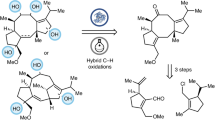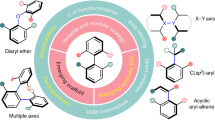Abstract
Four undescribed polyketide derivatives, named arthproliferins A–D (1–4), and one undescribed phenylspirodrimane derivative, named arthproliferin E (7), along with 11 known metabolites (5, 6, 8–16) were isolated from the soft coral-associated fungus Stachybotrys chartarum SCSIO41201. Their structures were determined through spectroscopic methods, X-ray crystallography, and ECD analysis. Compounds 1 and 3–15 were evaluated for their cytotoxic, and antibacterial activities. Among them, compounds 1 and 15 displayed moderate inhibitory activity against methicillin-resistant Staphylococcus aureus ATCC 29213 with an MIC value of 78 and 39 µg/mL, respectively. Furthermore, compound 15 displayed strong cytotoxic activities against the tested cell line with IC50 values less than 39 nM.
This is a preview of subscription content, access via your institution
Access options
Subscribe to this journal
Receive 12 print issues and online access
$259.00 per year
only $21.58 per issue
Buy this article
- Purchase on Springer Link
- Instant access to full article PDF
Prices may be subject to local taxes which are calculated during checkout





Similar content being viewed by others
References
Kamel HN, Slattery M. Terpenoids of Sinularia: chemistry and biomedical applications. Pharm Biol. 2005;43:253–69.
Cui W-X, Yang M, Li H, Li S-W, Yao L-G, Li G, et al. Polycyclic furanobutenolide-derived norditerpenoids from the South China Sea soft corals Sinularia scabra and Sinularia polydactyla with immunosuppressive activity. Bioorg Chem. 2020;94. https://doi.org/10.1016/j.bioorg.2019.103350.
Yang B, Huang J, Lin X, Liao S, Zhou X, Liu J, et al. New casbane diterpenoids from the hainan soft coral Sinularia Species. Hel Chim Acta. 2015;98:834–41.
Yang B, Liao S, Lin X, Wang J, Liu J, Zhou X, et al. New sinularianin sesquiterpenes from soft coral Sinularia sp. Mar Drugs. 2013;11:4741–50.
Yang B, Wei X, Huang J, Lin X, Liu J, Liao S, et al. Sinulolides A-H, new cyclopentenone and butenolide derivatives from soft coral Sinularia sp. Mar Drugs. 2014;12:5316–27.
Yang B, Zhou X, Huang H, Yang X-W, Liu J, Lin X, et al. New cembrane diterpenoids from a Hainan soft coral Sinularia sp. Mar Drugs. 2012;10:2023–32.
Shi Z-Z, Fang S-T, Miao F-P, Ji N-Y, Trichocarotins A-H. and trichocadinin A, nine sesquiterpenes from the marine-alga-epiphytic fungus Trichoderma virens. Bioorg Chem. 2018;81:319–25.
Hemphill CFP, Daletos G, Liu Z, Lin W, Proksch P. Polyketides from the mangrove-derived fungal endophyte Pestalotiopsis clavispora. Tetrahedron Lett. 2016;57:2078–83.
Gao H, Zhou L, Li D, Gu Q, Zhu T-J. New cytotoxic metabolites from the marine-derived fungus Penicillium sp ZLN29. Hel Chim Acta. 2013;96:514–9.
Kamalov LS, Aripova SF, Isaev MI. Low-molecular-mass metabolites of fungi. IV. The structures of stachybotrin A and stachybotral. Chem Nat Comp. 1999;35:82–85.
Wu B, Oesker V, Wiese J, Malien S, Schmaljohann R, Imhoff JF. Spirocyclic drimanes from the marine fungus Stachybotrys sp strain MF347. Mar Drugs. 2014;12:1924–38.
Li Y, Wu C, Liu D, Proksch P, Guo P, Lin W, Chartarlactams A-P. Phenylspirodrimanes from the sponge-associated fungus Stachybotrys chartarum with antihyperlipidemic activities. J Nat Prod. 2014;77:138–47.
Jarvis BB, Salemme J, Morais A. Stachybotrys toxins. 1. Nat toxins. 1995;3:10–16.
Sakai K, Watanabe K, Masuda K, Tsuji M, Hasumi K. Endo A. Isolation, characterization and biological activities of novel triprenyl phenols as pancreatic cholesterol esterase inhibitors produced by Stachybotrys sp. F-1839. J Antibiot. 1995;48:447–56.
Kwon Y-J, Sohn M-J, Kim H-J, Kim W-G. The lactone form of Stachybotrydial: a new inhibitor of dihydrofolate reductase from Stachybotrys sp FN298. Biol Pharm Bull. 2014;37:1406–10.
Eppley RM, Mazzola EP, Stack ME, Dreifuss PA. Structures of satratoxin F and satratoxin G, metabolites of Stachybotrys atra: application of proton and carbon-13 nuclear magnetic resonance spectroscopy. J Org Chem. 1980;45:2522–3.
Eppley RM, Mazzola EP, Highet RJ, Bailey WJ. Structure of satratoxin H, a metabolite of Stachybotrys atra. Application of proton and carbon-13 nuclear magnetic resonance. J Org Chem. 1977;42:240–3.
Gottschalk C, Bauer J, Meyer K. Detection of satratoxin G and H in indoor air from a water-damaged building. Mycopathologia. 2008;166:103–7.
Wilson KE, Tsou NN, Guan ZQ, Ruby CL, Pelaez F, Gorrochategui J, et al. Isolation and structure elucidation of coleophomones A and B, novel inhibitors of bacterial cell wall transglycosylase. Tetrahedron Lett. 2000;41:8705–9.
Nicolaou KC, Vassilikogiannakis G, Montagnon T. The total synthesis of coleophomones B and C. Angew Chem Int Edi. 2002;41:3410–5.
Nicolaou KC, Montagnon T, Vassilikogiannakis G, Mathison CJN. The total synthesis of coleophomones B, C, and D. J Am Chem Soc. 2005;127:8872–88.
Okada M, Saito K, Wong CP, Li C, Wang D, Iijima M, et al. Combinatorial biosynthesis of (+)-daurichromenic acid and its halogenated analogue. Org Lett. 2017;19:3183–6.
Kashiwada Y, Yamazaki K, Ikeshiro Y, Yamagishi T, Fujioka T, Mihashi K, et al. Isolation of rhododaurichromanic acid B and the anti-HIV principles rhododaurichromanic acid A and rhododaurichromenic acid from Rhododendron dauricum. Tetrahedron. 2001;57:1559–63.
Nishino C, Bowers WS. Stereoisomers of 3,7,11-trimethyldodeca-2,6,10-triene. Tetrahedron. 1976;32:2875–7.
Ma X, Wang H, Li F, Zhu T, Gu Q, Li D. Stachybotrin G, a sulfate meroterpenoid from a sponge derived fungus Stachybotrys chartarum MXH-X73. Tetrahedron Lett. 2015;56:7053–5.
Frelek J, Majer Z, Perkowska A, Snatzke G, Vlahov I, Wagner U. Absolute configuration of in situ transition metal complexes of ligating natural products from circular dichroism. Pure Appl Chem. 1985;57:441–51.
Fang W, Wang J, Wang J, Shi L, Li K, Lin X, et al. Cytotoxic and antibacterial eremophilane sesquiterpenes from the marine-derived fungus Cochliobolus lunatus SCSI041401. J Nat Prod. 2018;81:1405–10.
Wang J, Qin L, Zhao B, Cai L, Zhong Z, Liu Y, et al. Crotonols A and B, two rare tigliane diterpenoid derivatives against K562 cells from Croton tiglium. Org Biomol Chem. 2019;17:195–202.
Tao HM, Wei XY, Lin XP, Zhou XF, Dong JD, Yang B. Penixanthones A and B, two new xanthone derivatives from fungus Penicillium sp SYFz-1 derived of mangrove soil sample. Nat Prod Res. 2017;31:2218–22.
Acknowledgements
This study was supported by grants from the National Natural Science Foundation of China (21977102, 81860626, 81973235, and 21772210), Guangzhou Science and Technology Project (201804010462), the Natural Science Foundation of Guangdong Province (2018A0303130219), Special Funds for Promoting Economic Development (Marine Economic Development) of Guangdong Province (GDOE[2019]A28), National Major Scientific and Technological Special Project for Significant New Drugs Development (2018ZX09735001-002-003), Project from Institution of South China Sea Ecology and Environmental Engineering, CAS (ISEE2018PY04). We are grateful to Dr Z. Xiao, A. Sun, C. Li, and Y. Zhang in the analytical facilities at SCSIO for recording spectroscopic data.
Author information
Authors and Affiliations
Corresponding authors
Ethics declarations
Conflict of interest
The authors declare that they have no conflict of interest.
Additional information
Publisher’s note Springer Nature remains neutral with regard to jurisdictional claims in published maps and institutional affiliations.
Supplementary information
41429_2020_386_MOESM1_ESM.doc
Structurally Diverse Polyketides and Phenylspirodrimanes from the Soft Coral-associated Fungus Stachybotrys chartarum SCSIO41201
Rights and permissions
About this article
Cite this article
Yang, B., Long, J., Pang, X. et al. Structurally diverse polyketides and phenylspirodrimanes from the soft coral-associated fungus Stachybotrys chartarum SCSIO41201. J Antibiot 74, 190–198 (2021). https://doi.org/10.1038/s41429-020-00386-y
Received:
Revised:
Accepted:
Published:
Issue Date:
DOI: https://doi.org/10.1038/s41429-020-00386-y



